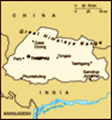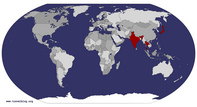Advertisement
Published: December 23rd 2007
Since I’m sick with a sore throat, I’m going to use this break in the action to give a little update.
I’m currently not in Thimphu. I was there a little over a week, and I am now in Samtse in the southwest of Bhutan, right on the border of the Indian tea area of West Bengal. Where as Thimphu was cold and dry at night and pleasant during the day, the lower elevation of Samtse is pleasant during night and day.
Thimphu is beautifully located in a mountainous valley that could be lifted right out of the Methow or the east side of the Sierra Nevada in California. The city kind of haphazardly sprawls mostly on the hills above the west side of a river called the Wang Chhu. Even though it’s the capital, it is probably about the size, in area, of Port Townsend.
Life is pretty easy going in Thimphu. No one’s in much of a rush to get anywhere, but I’m told there are increasingly more cars in Thimphu and there is actually a “rush hour” in the morning and evening. There are no traffic lights in Thimphu; one was installed a few years
ago, but it created a fair amount of confusion, so it was removed. The only traffic control is the well reported and photographed gesticulating police officer in a round about in the middle of town.
There is also a welcome conspicuous absence of fast food chains and big name retail stores. The “big” grocery store in town is a little bigger than a corner store in the US. However, in the many shops all over town there are Indian, Korean, and other products imported from all over. Shoes seem to be the most prevalent retail product. There are several electronics shops with small selections and high prices and many Buddhist trinket shops filled with products usually imported from Nepal. Every night, the whole town comes down to the main street, Norzin Lam, for their shopping or just to hang out and socialize or play a curious form of snooker that uses hand propelled chips instead of a cue stick and balls. The feeling in the city is like it must have been in a western city in the US in the late 1800s except there is internet infrastructure and cars.
There are a lot of new buildings and
construction projects all over town. They range from a new $1000 a night hotel - prominently situated like a palace in the middle of the landscape - to one of the many shopping complexes/mid-range hotels found all over the center of town. The main stadium is being renovated and there is a new facility being built for the Tarayana Foundation - the organization I’m volunteering with. Also, the road from Paro (about 1.5 hours away) is being widened and laid with new pavement that will shorten the drive time from the airport. All the construction projects are supposed to be completed by the time the new King, the 5th Druk Gyalpo, is enthroned in June.
The crown was handed over from the very popular 4th Druk Gyalpo - Jigme Singye Wangchuck - to his son - Jigme Khesar Namgyal Wangchuck about a year ago. The new King is proving to carry on his lineage’s very popular legacy of reforms and concerns for the common people; he is known as “the People’s King”. When I went to the National Day celebrations on Dec. 17, he meandered through the crowd, often sitting at length with people in the stands overlooking the
field where musicians and dancers performed. He showed little concern for the security measures that often divide people from leaders. I sincerely don’t think I’m buying into bogus hype. People I meet have a sincere gratefulness for the development policies of the Royal Government. Thousands of people showed up for the National Day celebrations and jockeyed for positions to meet the King.
I should mention, though democratization has been mandated and implemented in Bhutan for many years, a new constitution has been adopted and elections are underway. The first election is December 31 for the upper assembly - the National Council - with the next one for the General Assembly in February. Bhutan has adopted a two party system. The People’s Democratic Party (PDP) headed by Lyonpo Sangay Ngedup is represented by a white horse which people joke is a show horse who is not able to do hard work. The other party is the Druk Phuensum Tshogpa (DPT “Virtuous Bhutan Party”) headed by Lyonpo Jigme Thinley - a former Prime Minister of Bhutan. The DPT is represented by the Black Neck Crane -endangered migrant birds that are believed to be reincarnations of lamas. People joke that the DPT
will be migrant like the cranes, living in Bhutan only part of the year, then flying off to other places with the wealth.
All kidding aside. The Anti-Corruption Commission is a small office, but is currently engaged in preventative education and awareness. Fortunately, they don’t have much investigative work to do… yet. We’ll see how well honest open democracy takes root.
Something I noticed is the immigrant labor. Most road and building construction projects employed migrant Indian laborers. Their ramshackle houses lined the roads next to the projects where much of the labor is done by hand. Occasionally there is heavy equipment to do some of the digging. This is a curious relationship that I might not be able to find accurate information about.
On another note, the organization I’m volunteering with is called the Tarayana Foundation. Tara, a female Buddha, is the namesake of the organization. She is known for epic deeds of compassion. Tarayana is a very special organization and I am getting to know the profound depth of its mission during the two week youth volunteer training workshop that we are holding. The philosophy of Tarayana is to alleviate the suffering of the truly
dispossessed; those who are disadvantaged by handicap, old age, or sickness. The mission, as the Secretary General Aum Chime P. Wangdi humbly articulated yesterday, avoids prescription and looks for the source of a person’s suffering but also acts to relieve the suffering. She says that governments operate with prescriptions, therefore these people are the one’s who slip through the cracks. They are the one’s who need Tarayana’s assistance.
This workshop is also an opportunity for Tarayana to realign the Tarayana clubs from schools in every Dzongkhag (province, state) in Bhutan to be more effective in providing services as well as clarify the mission and operations. It is also an opportunity to provide skills training in leadership, mediation, presentation, time management, and confidentiality. Later in the session we will hike 7 hours to a remote village to help build a home at one of the Tarayana project sites. There are bout 145 students, teachers, and facilitators attending this workshop. A dedicated group, they have traveled from every part of Bhutan - some traveled for up to a week to get to Samtse and will travel another week to go home afterwards.
What would it take to do something in the US without prescription? Bhutan is uniquely special in its dedication to Gross National Happiness where these discussions on prescription enter the main stream consciousness of Bhutanese. It contravenes radical neo-liberal development policies that assert prescriptions and models on people that don’t need it and remove people from their social structures in pursuit of products rather than familiarity with true sources of happiness. They need care and compassion.
The drive from Thimphu to Samtse was incredible. We passed from high elevation steep valleys on one track mostly dirt roads down to the tea plains of India. We stopped for a night in Phuentsholing where the border is pretty much porous. I had to search for the right place to get my passport stamped; no need on the Bhutan side, just a stamp n my travel permit for the region I’m traveling in. On the Indian side: what was that transit visa for? No one seems to care to check and I was assured by the Bhutanese immigration official that there was no need for an exit stamp from India. So much for formalities.
Fortunately, my Bhutan visa was extended until June with multiple entries! I will most likely stay in Bhutan until March. One of the major challenges is getting money from my bank account in the US into currency here in Bhutan (incredibly, this is my major challenge). There are no ATMs. My current plan is to travel to Delhi to potentially visit a Tibetan camp with my friend Dolma, then travel to Himachel Pradesh to volunteer at the Deer Park Institute. I should end up in Ladakh in June, but I’m thinking of coming to Bhutan for the King’s coronation.
Advertisement
Tot: 0.075s; Tpl: 0.012s; cc: 6; qc: 46; dbt: 0.0383s; 1; m:domysql w:travelblog (10.17.0.13); sld: 1;
; mem: 1.1mb











scot nichols
non-member comment
from txas in xmas
Great to hear your stories of Bhutan, sounds like it could actually be possible to travel there without much hassel. Well I am craving a bit of the 1800's right now, as I am in the heat of religious spending and silent cultural tryanny-texas in christmas. Your journey sounds beautiful, thanks for sharing. bewell Scot